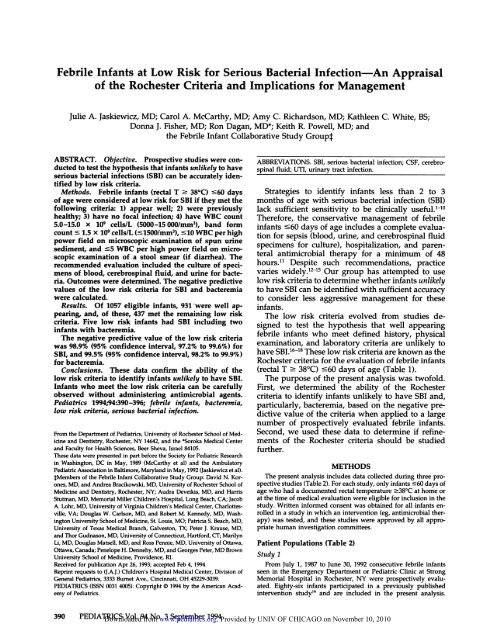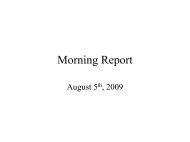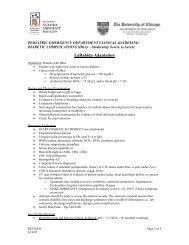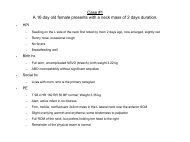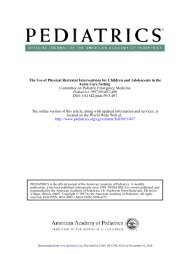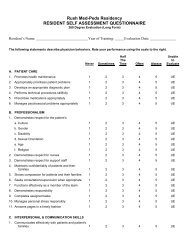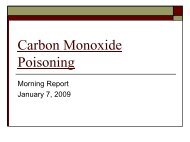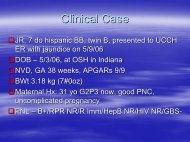the Rochester criteria - Department of Pediatrics
the Rochester criteria - Department of Pediatrics
the Rochester criteria - Department of Pediatrics
Create successful ePaper yourself
Turn your PDF publications into a flip-book with our unique Google optimized e-Paper software.
Febrile Infants at Low Risk for Serious Bacterial Infection-An Appraisal<br />
<strong>of</strong> <strong>the</strong> <strong>Rochester</strong> Criteria and Implications for Management<br />
Julie A. Jaskiewicz, MD; Carol A. McCarthy, MD; Amy C. Richardson, MD; Kathleen C. White, BS;<br />
Donna J. Fisher, MD; Ron Dagan, MD*; Keith R. Powell, MD; and<br />
ABSTRACT. Objective. Prospective studies were conducted<br />
to test <strong>the</strong> hypo<strong>the</strong>sis that infants unlikely to have<br />
serious bacterial infections (SBI) can be accurately identified<br />
by low risk <strong>criteria</strong>.<br />
Methods. Febrile infants (rectal T 38#{176}C) 60 days<br />
<strong>of</strong> age were considered at low risk for SBI if <strong>the</strong>y met <strong>the</strong><br />
following <strong>criteria</strong>: 1) appear well; 2) were previously<br />
healthy; 3) have no focal infection; 4) have WBC count<br />
5.0-15.0 x 10 cells/L (5000-15 000/mm3), band form<br />
count 1.5 x 10 cells/L (1500/mm3), 10 WBC per high<br />
power field on microscopic examination <strong>of</strong> spun urine<br />
sediment, and 5 WBC per high power field on microscopic<br />
examination <strong>of</strong> a stool smear (if diarrhea). The<br />
recommended evaluation included <strong>the</strong> culture <strong>of</strong> specimens<br />
<strong>of</strong> blood, cerebrospinal fluid, and urine for bacteria<br />
Outcomes were determined. The negative predictive<br />
values <strong>of</strong> <strong>the</strong> low risk <strong>criteria</strong> for SBI and bacteremia<br />
were calculated.<br />
Results. Of 1057 eligible infants, 931 were well appearing,<br />
and, <strong>of</strong> <strong>the</strong>se, 437 met <strong>the</strong> remaining low risk<br />
<strong>criteria</strong>. Five low risk infants had SB! including two<br />
infants with bacteremia.<br />
The negative predictive value <strong>of</strong> <strong>the</strong> low risk <strong>criteria</strong><br />
was 98.9% (95% confidence interval, 97.2% to 99.6%) for<br />
SB!, and 99.5% (95% confidence interval, 98.2% to 99.9%)<br />
for bacteremia.<br />
Conclusions. These data confirm <strong>the</strong> ability <strong>of</strong> <strong>the</strong><br />
low risk <strong>criteria</strong> to identify infants unlikely to have SB!.<br />
Infants who meet <strong>the</strong> low risk <strong>criteria</strong> can be carefully<br />
observed without administering antimicrobial agents.<br />
<strong>Pediatrics</strong> 1994;94:390-.396; febrile infants, bacteremia,<br />
low risk <strong>criteria</strong>, serious bacterial infection.<br />
From <strong>the</strong> <strong>Department</strong> <strong>of</strong> <strong>Pediatrics</strong>, University <strong>of</strong> <strong>Rochester</strong> School <strong>of</strong> Medicine<br />
and Dentistry, <strong>Rochester</strong>, NY 14642, and <strong>the</strong> ‘Soroka Medical Center<br />
and Faculty for Health Sciences, Beer Sheva, Israel 84105.<br />
These data were presented in part before <strong>the</strong> Society for Pediatric Research<br />
in Washington, DC in May, 1989 (McCarthy et al) and <strong>the</strong> Ambulatory<br />
Pediatric Association in Baltimore, Maryland in May, 1992 (Jaskiewicz et al).<br />
Members <strong>of</strong> <strong>the</strong> Febrile Infant Collaborative Study Group: David N. Korones,<br />
MD, and Andrea Bracikowski, MD, University <strong>of</strong> <strong>Rochester</strong> School <strong>of</strong><br />
Medicine and Dentistry, <strong>Rochester</strong>, NY; Audra Deveikis, MD, and Harris<br />
Stutman, MD, Memorial Miller Children’s Hospital, Long Beach, CA; Jacob<br />
A. Lohr, MD, University <strong>of</strong> Virginia Children’s Medical Center, Charlottesvile,<br />
VA; Douglas W. Carlson, MD, and Robert M. Kennedy, MD, Washington<br />
University School <strong>of</strong> Medicine, St. Loins, MO; Patricia S. Beach, MD,<br />
University <strong>of</strong> Texas Medical Branch, Galveston, TX; Peter J. Krause, MD,<br />
and Thor Gudnason, MD, University <strong>of</strong> Connecticut, Hartford, CT; Marilyn<br />
Li, MD, Douglas Matsell, MD, and Ross Pennie, MD, University <strong>of</strong> Ottawa,<br />
Ottawa, Canada; Penelope H. Dennehy, MD, and Georges Peter, MD Brown<br />
University School <strong>of</strong> Medicine, Providence, RI.<br />
Received for publication Apr 26, 1993; accepted Feb 4, 1994.<br />
Reprint requests to (J.A.J.) Children’s Hospital Medical Center, Division <strong>of</strong><br />
General <strong>Pediatrics</strong>, 3333 Burnet Ave., Cincinnati, OH 45229-3039.<br />
PEDIATRICS (ISSN 0031 4005). Copyright © 1994 by <strong>the</strong> American Academy<br />
<strong>of</strong> <strong>Pediatrics</strong>.<br />
<strong>the</strong> Febrile Infant Collaborative Study Groups<br />
ABBREVIATIONS. SB!, seriousbacterial infection; CSF, cerebrospinal<br />
fluid; UT!, urinary tract infection.<br />
Strategies to identify infants less than 2 to 3<br />
months <strong>of</strong> age with serious bacterial infection (SBI)<br />
lack sufficient sensitivity to be clinically useful.’#{176}<br />
Therefore, <strong>the</strong> conservative management <strong>of</strong> febrile<br />
infants 60 days <strong>of</strong> age includes a complete evaluation<br />
for sepsis (blood, urine, and cerebrospinal fluid<br />
specimens for culture), hospitalization, and parenteral<br />
antimicrobial <strong>the</strong>rapy for a minimum <strong>of</strong> 48<br />
hours.11 Despite such recommendations, practice<br />
varies widely.’25 Our group has attempted to use<br />
low risk <strong>criteria</strong> to determine whe<strong>the</strong>r infants unlikely<br />
to have SBI can be identified with sufficient accuracy<br />
to consider less aggressive management for <strong>the</strong>se<br />
infants.<br />
The low risk <strong>criteria</strong> evolved from studies designed<br />
to test <strong>the</strong> hypo<strong>the</strong>sis that well appearing<br />
febrile infants who meet defined history, physical<br />
examination, and laboratory <strong>criteria</strong> are unlikely to<br />
have SBI.16’8 These low risk <strong>criteria</strong> are known as <strong>the</strong><br />
<strong>Rochester</strong> <strong>criteria</strong> for <strong>the</strong> evaluation <strong>of</strong> febrile infants<br />
(rectal T 38#{176}C)60 days <strong>of</strong> age (Table 1).<br />
The purpose <strong>of</strong> <strong>the</strong> present analysis was tw<strong>of</strong>old.<br />
First, we determined <strong>the</strong> ability <strong>of</strong> <strong>the</strong> <strong>Rochester</strong><br />
<strong>criteria</strong> to identify infants unlikely to have SBI and,<br />
particularly, bacteremia, based on <strong>the</strong> negative predictive<br />
value <strong>of</strong> <strong>the</strong> <strong>criteria</strong> when applied to a large<br />
number <strong>of</strong> prospectively evaluated febrile infants.<br />
Second, we used <strong>the</strong>se data to determine if refinements<br />
<strong>of</strong> <strong>the</strong> <strong>Rochester</strong> <strong>criteria</strong> should be studied<br />
fur<strong>the</strong>r.<br />
METHODS<br />
The present analysis includes data collected during three prospective<br />
studies (Table 2). For each study, only infants 60 days <strong>of</strong><br />
age who had a documented rectal temperature 38#{176}Cat home or<br />
at <strong>the</strong> time <strong>of</strong> medical evaluation were eligible for inclusion in <strong>the</strong><br />
study. Written informed consent was obtained for all infants enrolled<br />
in a study in which an intervention (eg, antimicrobial <strong>the</strong>rapy)<br />
was tested, and <strong>the</strong>se studies were approved by all appropnate<br />
human investigation committees.<br />
Patient Populations (Table 2)<br />
Study 1<br />
From July 1, 1987 to June 30, 1992 consecutive febrile infants<br />
seen in <strong>the</strong> Emergency <strong>Department</strong> or Pediatric Clinic at Strong<br />
Memorial Hospital in <strong>Rochester</strong>, NY were prospectively evaluated.<br />
Eighty-six infants participated in a previously published<br />
intervention study9 and are included in <strong>the</strong> present analysis.<br />
390 PEDIATRICS Downloaded Vol. 94from No. www.pediatrics.org<br />
3 September 1994.<br />
Provided by UNIV OF CHICAGO on November 10, 2010


